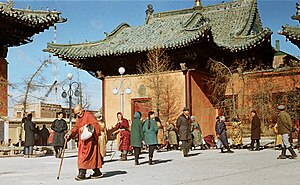Looking back to my junior high history class (or trying to anyway), I only remember learning about Genghis Khan and the Mongolian empire because I found their culture the most fascinating. It occurs to me now that we never spent much time on the burial rites of the culture. In my attempt to rekindle some old school enthusiasm, I did my own research on Mongolian funeral customs and was intrigued by what I found.
The traditional ceremony involves several steps. When a loved one has passed away, the first step is to call up the lamas because they direct the entire process. Depending on the social standing of the loved one, a certain number of lamas are required. From there, they decide exactly when and where the ceremony will take place. During this time, the family and lamas prey and offer food to keep evil spirits away. In addition, they place blue stones around the loved one’s body to prevent evil spirits from contacting him or her. For all other good visiting spirits, the family burns incense and leaves food out.
In Mongolian culture, they believe in returning the soul to its source, which is the
primary reason for funeral ceremonies. While the ceremony is taking place, no one is allowed to touch the loved one who has passed except for a lama. When the time comes to move him or her, they must be passed through a window or through a hole in the wall to prevent evil spirits from creeping in through the door. Once taken away from the village, the loved one is placed on the ground and encircled by stones. They are then left to natural predators and local dogs. When the physical body is no longer there, the stone outline is meant to represent the loved one’s spirit. If the family does not complete each one of these steps, it is believed they will be plagued by bad karma.

 Mongolian Air Sacrifice
Mongolian Air Sacrifice




 Our Annual Seven Holiday Gifts for Someone Who Is Grieving, 2024 Edition
Our Annual Seven Holiday Gifts for Someone Who Is Grieving, 2024 Edition
 “Making Mobiles” by Karolina Merska
“Making Mobiles” by Karolina Merska
 “Hands Up to the Sky” by Michael Franti & Spearhead
“Hands Up to the Sky” by Michael Franti & Spearhead














